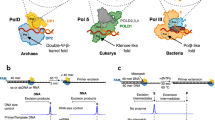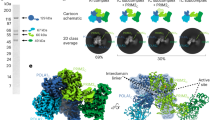Abstract
DNA polymerase μ (Pol μ) is a family X enzyme with unique substrate specificity that contributes to its specialized role in nonhomologous DNA end joining (NHEJ). To investigate Pol μ's unusual substrate specificity, we describe the 2.4 Å crystal structure of the polymerase domain of murine Pol μ bound to gapped DNA with a correct dNTP at the active site. This structure reveals substrate interactions with side chains in Pol μ that differ from other family X members. For example, a single amino acid substitution, H329A, has little effect on template-dependent synthesis by Pol μ from a paired primer terminus, but it reduces both template-independent and template-dependent synthesis during NHEJ of intermediates whose 3′ ends lack complementary template strand nucleotides. These results provide insight into the substrate specificity and differing functions of four closely related mammalian family X DNA polymerases.
This is a preview of subscription content, access via your institution
Access options
Subscribe to this journal
Receive 12 print issues and online access
$189.00 per year
only $15.75 per issue
Buy this article
- Purchase on Springer Link
- Instant access to full article PDF
Prices may be subject to local taxes which are calculated during checkout








Similar content being viewed by others
Change history
15 June 2007
updated crystallization locations
Notes
*NOTE: In the version of this article initially published, the crystallization conditions were incorrectly reported. The correct conditions are as follows: 95 mM sodium citrate (pH 5.6), 19% (v/v) isopropanol, 19% (w/v) PEG 4,000 and 5% (v/v) glycerol. The error has been corrected in the HTML and PDF versions of the article. The authors apologize for any inconvenience this may have caused.
References
Bebenek, K. & Kunkel, T.A. Functions of DNA polymerases. Adv. Protein Chem. 69, 137–165 (2004).
Braithwaite, E.K. et al. DNA polymerase lambda mediates a back-up base excision repair activity in extracts of mouse embryonic fibroblasts. J. Biol. Chem. 280, 18469–18475 (2005).
Garcia-Diaz, M., Bebenek, K., Kunkel, T.A. & Blanco, L. Identification of an intrinsic 5′-deoxyribose-5-phosphate lyase activity in human DNA polymerase lambda: a possible role in base excision repair. J. Biol. Chem. 276, 34659–34663 (2001).
Fan, W. & Wu, X. DNA polymerase lambda can elongate on DNA substrates mimicking non-homologous end joining and interact with XRCC4-ligase IV complex. Biochem. Biophys. Res. Commun. 323, 1328–1333 (2004).
Lee, J.W. et al. Implication of DNA polymerase lambda in alignment-based gap filling for nonhomologous DNA end joining in human nuclear extracts. J. Biol. Chem. 279, 805–811 (2004).
Nick McElhinny, S.A. et al. A gradient of template dependence defines distinct biological roles for family X polymerases in nonhomologous end joining. Mol. Cell 19, 357–366 (2005).
Bertocci, B., De Smet, A., Weill, J.C. & Reynaud, C.A. Nonoverlapping functions of DNA polymerases mu, lambda, and terminal deoxynucleotidyltransferase during immunoglobulin V(D)J recombination in vivo. Immunity 25, 31–41 (2006).
Lieber, M.R. The polymerases for v(d)j recombination. Immunity 25, 7–9 (2006).
Bollum, F. Terminal deoxynucleotidyl transferase. The Enzymes 10, 145–171 (1974).
Gilfillan, S., Benoist, C. & Mathis, D. Mice lacking terminal deoxynucleotidyltransferase: adult mice with a fetal antigen receptor repertoire. Immunol. Rev. 148, 201–219 (1995).
Bertocci, B., De Smet, A., Berek, C., Weill, J.C. & Reynaud, C.A. Immunoglobulin kappa light chain gene rearrangement is impaired in mice deficient for DNA polymerase mu. Immunity 19, 203–211 (2003).
Mahajan, K.N., Nick McElhinny, S.A., Mitchell, B.S. & Ramsden, D.A. Association of DNA polymerase mu (Pol mu) with Ku and ligase IV: role for Pol mu in end-joining double-strand break repair. Mol. Cell. Biol. 22, 5194–5202 (2002).
Dominguez, O. et al. DNA polymerase mu (Pol mu), homologous to TdT, could act as a DNA mutator in eukaryotic cells. EMBO J. 19, 1731–1742 (2000).
Zhang, Y., Wu, X., Yuan, F., Xie, Z. & Wang, Z. Highly frequent frameshift DNA synthesis by human DNA polymerase mu. Mol. Cell. Biol. 21, 7995–8006 (2001).
Zhang, Y. et al. Lesion bypass activities of human DNA polymerase mu. J. Biol. Chem. 277, 44582–44587 (2002).
Covo, S., Blanco, L. & Livneh, Z. Lesion bypass by human DNA polymerase mu reveals a template-dependent, sequence-independent nucleotidyl transferase activity. J. Biol. Chem. 279, 859–865 (2004).
Nick McElhinny, S.A. & Ramsden, D.A. Polymerase mu is a DNA-directed DNA/RNA polymerase. Mol. Cell. Biol. 23, 2309–2315 (2003).
Ruiz, J.F. et al. Lack of sugar discrimination by human Pol mu requires a single glycine residue. Nucleic Acids Res. 31, 4441–4449 (2003).
Davies, J.F., II, Almassy, R.J., Hostomska, Z., Ferre, R.A. & Hostomsky, Z. 2.3 Å crystal structure of the catalytic domain of DNA polymerase beta. Cell 76, 1123–1133 (1994).
Sawaya, M.R., Pelletier, H., Kumar, A., Wilson, S.H. & Kraut, J. Crystal structure of rat DNA polymerase beta: evidence for a common polymerase mechanism. Science 264, 1930–1935 (1994).
Pelletier, H., Sawaya, M.R., Wolfle, W., Wilson, S.H. & Kraut, J. Crystal structures of human DNA polymerase beta complexed with DNA: implications for catalytic mechanism, processivity, and fidelity. Biochemistry 35, 12742–12761 (1996).
Sawaya, M.R., Prasad, R., Wilson, S.H., Kraut, J. & Pelletier, H. Crystal structures of human DNA polymerase beta complexed with gapped and nicked DNA: evidence for an induced fit mechanism. Biochemistry 36, 11205–11215 (1997).
Garcia-Diaz, M. et al. A structural solution for the DNA polymerase lambda-dependent repair of DNA gaps with minimal homology. Mol. Cell 13, 561–572 (2004).
Garcia-Diaz, M., Bebenek, K., Krahn, J.M., Kunkel, T.A. & Pedersen, L.C. A closed conformation for the Pol lambda catalytic cycle. Nat. Struct. Mol. Biol. 12, 97–98 (2005).
Garcia-Diaz, M. et al. Structure-function studies of DNA polymerase lambda. DNA Repair (Amst.) 4, 1358–1367 (2005).
Garcia-Diaz, M., Bebenek, K., Krahn, J.M., Pedersen, L.C. & Kunkel, T.A. Structural analysis of strand misalignment during DNA synthesis by a human DNA polymerase. Cell 124, 331–342 (2006).
Delarue, M. et al. Crystal structures of a template-independent DNA polymerase: murine terminal deoxynucleotidyltransferase. EMBO J. 21, 427–439 (2002).
Doherty, A.J., Serpell, L.C. & Ponting, C.P. The helix-hairpin-helix DNA-binding motif: a structural basis for non-sequence-specific recognition of DNA. Nucleic Acids Res. 24, 2488–2497 (1996).
Osheroff, W.P., Jung, H.K., Beard, W.A., Wilson, S.H. & Kunkel, T.A. The fidelity of DNA polymerase beta during distributive and processive DNA synthesis. J. Biol. Chem. 274, 3642–3650 (1999).
Osheroff, W.P., Beard, W.A., Yin, S., Wilson, S.H. & Kunkel, T.A. Minor groove interactions at the DNA polymerase beta active site modulate single-base deletion error rates. J. Biol. Chem. 275, 28033–28038 (2000).
Latham, G.J. et al. Vertical-scanning mutagenesis of a critical tryptophan in the “minor groove binding track” of HIV-1 reverse transcriptase. J. Biol. Chem. 275, 15025–15033 (2000).
Batra, V.K. et al. Magnesium induced assembly of a complete DNA polymerase catalytic complex. Structure 14, 757–766 (2006).
Beese, L.S. & Steitz, T.A. Structural basis for the 3′-5′ exonuclease activity of Escherichia coli DNA polymerase I: a two metal ion mechanism. EMBO J. 10, 25–33 (1991).
Gryk, M.R. et al. Mapping of the interaction interface of DNA polymerase beta with XRCC1. Structure 10, 1709–1720 (2002).
Juarez, R., Ruiz, J.F., McElhinny, S.A., Ramsden, D. & Blanco, L. A specific loop in human DNA polymerase mu allows switching between creative and DNA-instructed synthesis. Nucleic Acids Res. 34, 4572–4582 (2006).
Garcia-Diaz, M. et al. DNA polymerase lambda, a novel DNA repair enzyme in human cells. J. Biol. Chem. 277, 13184–13191 (2002).
Chayen, N.E. Comparative studies of protein crystallization by vapour-diffusion and microbatch techniques. Acta Crystallogr. D Biol. Crystallogr. 54, 8–15 (1998).
Otwinowski, Z. & Minor, V. Processing of X-ray diffraction data collected in oscillation mode. Methods Enzymol. 276, 307–326 (1997).
Collaborative Computational Project, Number 4. The CCP4 suite: programs for protein crystallography. Acta Crystallogr. D Biol. Crystallogr. 50, 760–763 (1994).
Vagin, A. & Teplyakov, A. MOLREP: an automated program for molecular replacement. J. Appl. Cryst. 30, 1022–1025 (1997).
Jones, T.A., Zou, J., Cowan, S. & Kjeldgaard, M. Improved methods for building protein models in electron density maps and the location of errors in these models. Acta Crystallogr. A 47, 110–119 (1991).
Brunger, A.T. et al. Crystallography & NMR system: A new software suite for macromolecular structure determination. Acta Crystallogr. D Biol. Crystallogr. 54, 905–921 (1998).
Lovell, S.C. et al. Structure validation by Calpha geometry: phi,psi and Cbeta deviation. Proteins 50, 437–450 (2003).
Kraulis, P. MOLSCRIPT: a program to produce both detailed and schematic plots of proteins. J. Appl. Cryst. 24, 946–950 (1991).
Merritt, E.A. & Murphy, M.E. Raster3D Version 2.0. A program for photorealistic molecular graphics. Acta Crystallogr. D Biol. Crystallogr. 50, 869–873 (1994).
Nick McElhinny, S.A., Snowden, C.M., McCarville, J. & Ramsden, D.A. Ku recruits the XRCC4-ligase IV complex to DNA ends. Mol. Cell. Biol. 20, 2996–3003 (2000).
Acknowledgements
We thank T. Hall and S.Nick McElhinny for critical reading and thoughtful comments on the manuscript. This research was funded in part by the Division of Intramural Research of the National Institute of Environmental Health Sciences, US National Institutes of Health, and in part by US National Institutes of Health grant CA097096 to D.A.R. The Advanced Photon Source used for this study was supported by the US Department of Energy, Office of Science, Office of Basic Energy Sciences, under contract no. W-31-109-Eng-38. We thank Z. Jin for collecting these data at SER-CAT using mail-in crystallography.
Author information
Authors and Affiliations
Contributions
A.F.M., cloning, expression and purification of proteins used for biochemistry and crystallography, crystallization of catalytic domain of murine Pol μ; M.G.-D., expression and purification of proteins to be used for biochemical assays, kinetic analysis of human Pol μ and TdT; K.B., analysis of enzymatic activity for human Pol μ and TdT proteins; B.S.D., analysis of end-joining activity for human Pol μ in NHEJ assays; X.Z., early crystallization trials with human Pol μ; D.A.R., analysis of end-joining activity for human Pol μ and interpretation of data from NHEJ assays; L.C.P., analysis of crystallization data and refinement of Pol μ structural model; T.A.K., experimental design and analysis of biochemical data. All authors contributed to experimental design, interpretation of results and preparation of the manuscript.
Corresponding author
Ethics declarations
Competing interests
The authors declare no competing financial interests.
Rights and permissions
About this article
Cite this article
Moon, A., Garcia-Diaz, M., Bebenek, K. et al. Structural insight into the substrate specificity of DNA Polymerase μ. Nat Struct Mol Biol 14, 45–53 (2007). https://doi.org/10.1038/nsmb1180
Received:
Accepted:
Published:
Issue Date:
DOI: https://doi.org/10.1038/nsmb1180
This article is cited by
-
Structural snapshots of human DNA polymerase μ engaged on a DNA double-strand break
Nature Communications (2020)
-
Quaternary structural diversity in eukaryotic DNA polymerases: monomeric to multimeric form
Current Genetics (2020)
-
Structure and function relationships in mammalian DNA polymerases
Cellular and Molecular Life Sciences (2020)
-
Time-lapse crystallography snapshots of a double-strand break repair polymerase in action
Nature Communications (2017)
-
How DNA polymerases catalyse replication and repair with contrasting fidelity
Nature Reviews Chemistry (2017)



